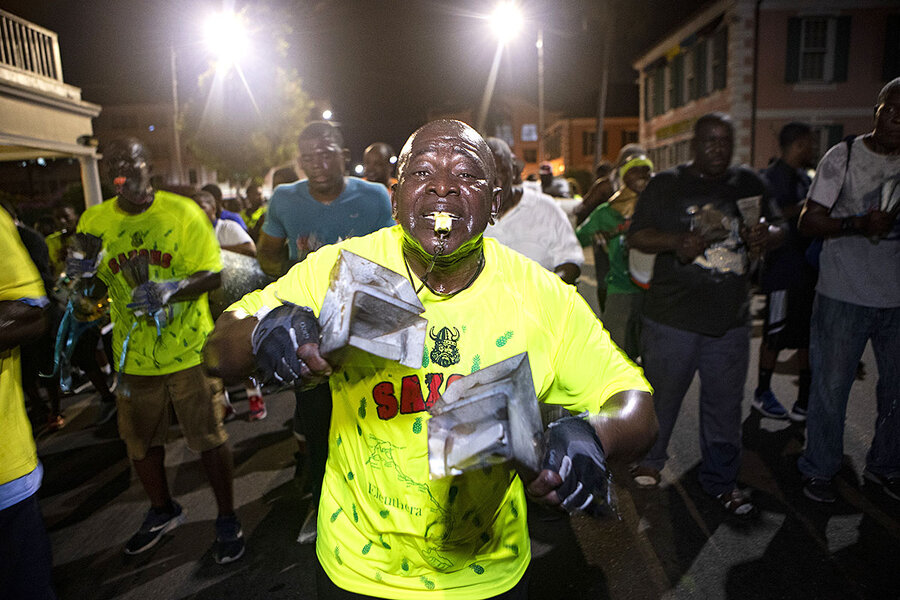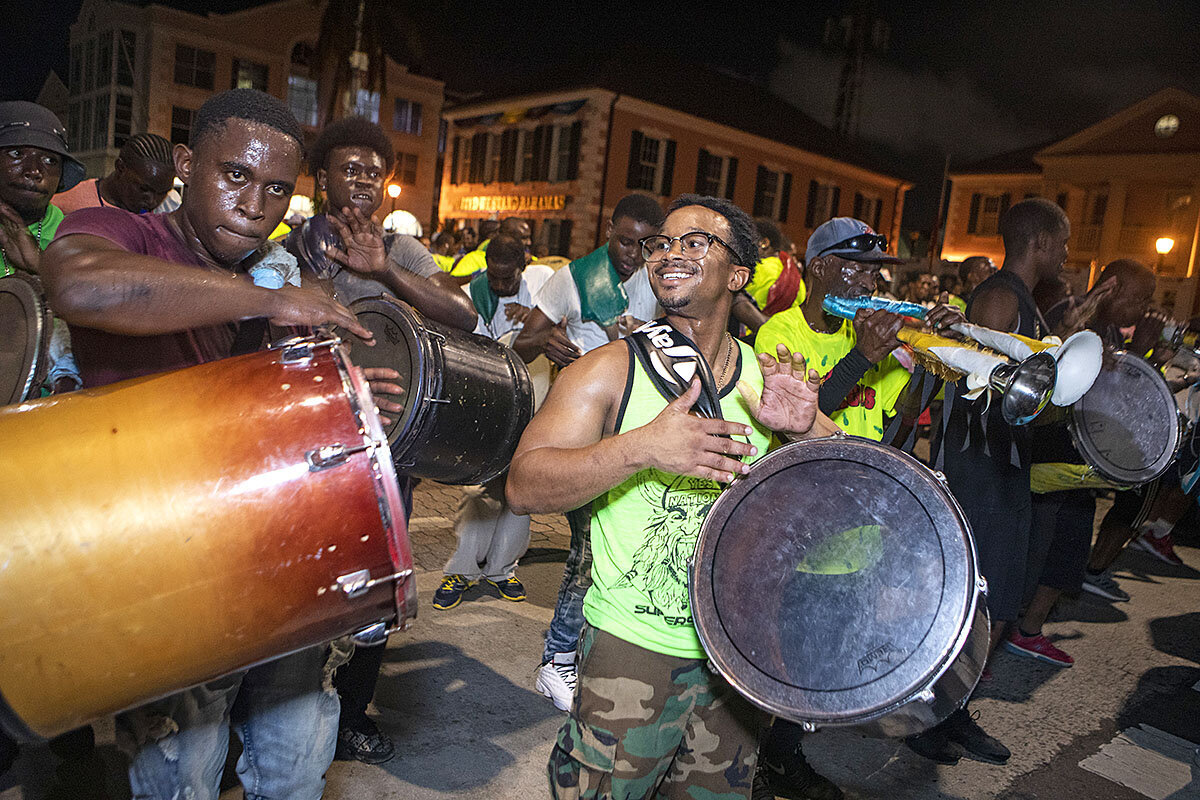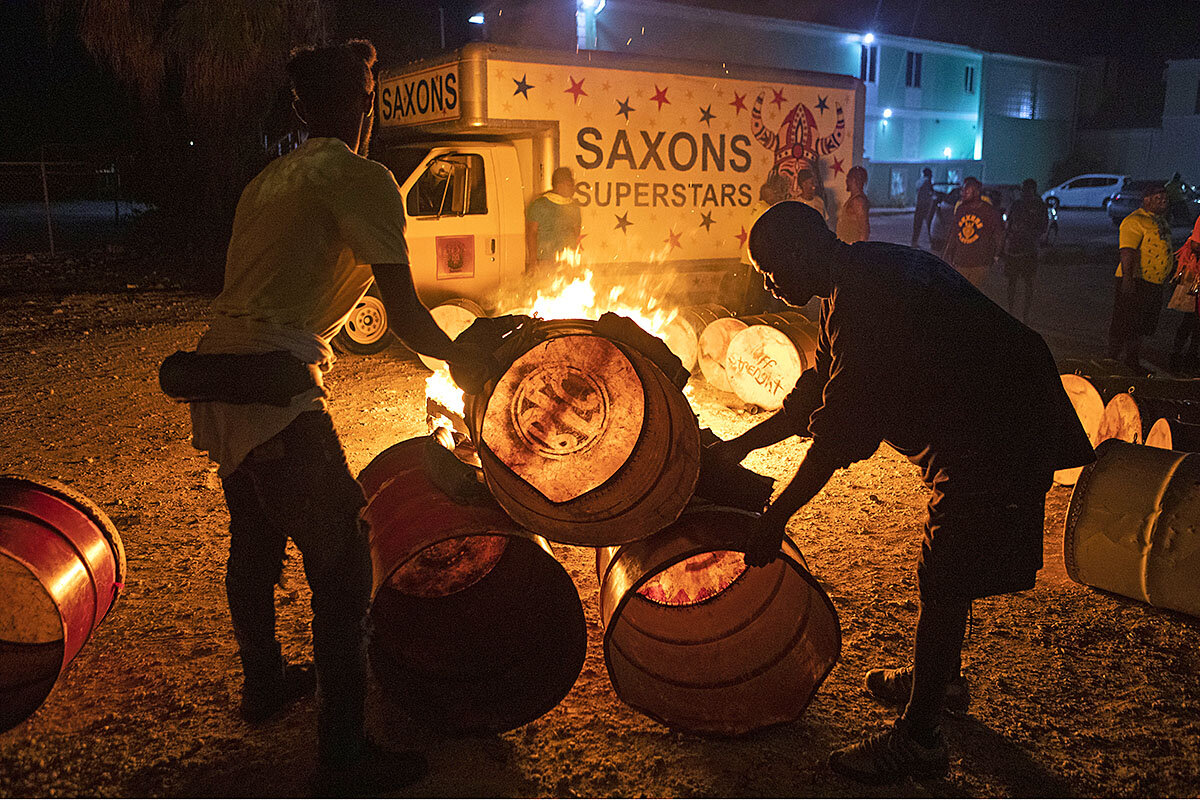‘It wouldn’t be Christmas without Junkanoo.’ How Bahamians make merry.
Loading...
| Nassau, Bahamas
In the Bahamas, Christmas night means Junkanoo. Nassau residents head not to bed but to downtown Bay Street, in raucous groups that beat goat-skinned drums. The junkanooers “rush out” into dance, wearing fanciful costumes of rainbow-colored crepe paper.
Junkanoo is an exuberant expression of Bahamian culture with African slave roots. It’s among the most unifying traditions in the Bahamas, and perhaps this year more than ever after Category 5 Hurricane Dorian devastated parts of the island nation in September. “It lifts the spirits,” says Arlene Nash Ferguson, a junkanooer and cultural historian. She says Junkanoo grew from Christmas tradition, when the British Crown granted everyone, including slaves, three days off in its Caribbean colonies. They used the time to re-create their festivals from home.
Why We Wrote This
In the Bahamas, holidays spill out of homes and into the streets, drawn by the power of a parade. A tradition reclaimed from colonial days unifies the country through costumes and cowbells.
Today’s parades are competitive. Much like Carnival in Rio de Janeiro, the entire year is spent saving money for costumes and rehearsing. The biggest parade takes place on Christmas night through Boxing Day the following morning. Then the groups do it again just after the clocks strike midnight on New Year’s Day – and a handful of other celebrations year-round.
“It is like the biggest show on earth for us,” says Nassau local Dudley Gilbert. “I live for this.”
On Christmas night, after church services are over, after the children have finished unwrapping gifts, after the turkey is finished and the plates are washed, most people fall, if they don’t collapse, into a deep lull.
But not in the Bahamas. Here, Christmas night means Junkanoo, an exuberant expression of Bahamian culture with African slave roots. In Nassau, residents head not to bed but to downtown Bay Street, in raucous and deafening groups that shake cowbells and beat goat-skinned drums. The junkanooers “rush out” into dance, wearing fanciful costumes of rainbow-colored crepe paper glued onto cardboard and held together with aluminum rods. Some can weigh over 100 pounds.
Dudley Gilbert, a retired engineer, is ceaselessly blowing a whistle that doesn’t leave his mouth, using his hands for the constant ringing of two cowbells. This is a November rehearsal for his group, the Saxons Superstars, in downtown Nassau. To the tunes of “Amazing Grace” and “Down By the Riverside,” the trance-like beat is so irresistible that bystanders join the troupe, dancing and twirling alongside them.
Why We Wrote This
In the Bahamas, holidays spill out of homes and into the streets, drawn by the power of a parade. A tradition reclaimed from colonial days unifies the country through costumes and cowbells.
It’s a far cry from solemn Christmas caroling that is more commonly associated with the music of the season. But for Bahamians, “It wouldn’t be Christmas without Junkanoo,” Mr. Gilbert says.
Creative resistance
Junkanoo is among the most unifying traditions in the Bahamas, and perhaps this year more than ever after Category 5 Hurricane Dorian devastated parts of the island nation in September.
Junkanoo isn’t just for Christmastime, but its biggest parade takes place on Christmas night, starting at 10 p.m., through Boxing Day the following morning. Then the groups do it again just after the clocks strike midnight on New Year’s Day – not to mention for Independence Day celebrations, summer festivals, and jam sessions year-round.
The parades are competitive, and much like Carnival in Rio de Janeiro, the entire year is spent saving money for costumes, creating them in “shacks” – structures typically in the back of someone’s house, dedicated exclusively to the whimsical outfits – and to rehearsing the beat, the rhythm, and the choreography of each group’s show.
Arlene Nash Ferguson is a junkanooer and cultural historian. She runs a museum dedicated to the practice, called Educulture Bahamas, in her childhood home in Nassau where she showcases all of the costumes she has worn over a lifetime (created by her husband Silbert Ferguson, a former president of the Junkanoo Corp. of New Providence, the island where the capital Nassau is located).
She says that Junkanoo grew from Christmas tradition – the most important time of year in the Anglican calendar – when the British Crown granted everyone, including slaves, three days off in its Caribbean colonies. They used the time to recreate their festivals from home, using feathers or any materials they could for costumes.
“That it started as a resistance reflects the strength of the people of the Bahamas, who could have the strength of character to renew and celebrate their essence in the thick of one of the most inhumane circumstances known to man, chattel slavery,” she says. “You are affirming, if only to yourself, ‘no, I’m not an animal.’”
Educulture runs workshops for school groups so that Bahamian children understand the true meaning of Junkanoo beyond the competition and cash prizes.
Ms. Ferguson hosts a Saturday morning radio program on Junkanoo. She asked one of her guests how Hurricane Dorian would impact the parades this year.
“He said, in essence, ‘you have an obligation to put them on. ... For all the refugees who have come to New Providence, let Junkanoo do what it does best,’” she recalls. “It lifts the spirits. I thought that was so profound, to ensure that those parades go on at Christmas.”
For entertainers like Ms. Ferguson, Junkanoo is a compulsion. “We do not understand what drives us to go into these dilapidated buildings and work on these costumes all year just for a few hours on Bay Street,” she says. “For me, this is another opportunity to trace the footsteps of the people who made it possible for me to be here.”
‘I live for this’
During Junkanoo season, which starts in the fall, rehearsals take place throughout the Bahamian capital. On a recent Sunday in a parking lot at Arawak Cay, where Nassau’s “fish fry” is located, smoke from a bonfire billows into the humid air. Around it lie 23 goat-skinned drums, heated to make them taut. This is the Saxons Superstars’ usual rehearsal spot.
Marvin Roberts, a lead drummer for the group and mattress factory worker, says he’s been a junkanooer since age 14. “It kept me out of trouble,” he says. But what’s kept him coming back for 25 years, he says, is the camaraderie, uniting young and old, blue collar and professional. Their stamina is impressive. They fall into line at 9 p.m. and practice for hours, never letting go of the beat – or the volume.
“It is like the biggest show on earth for us,” says Mr. Gilbert. “I live for this. I can’t wait for this time of the year. It’s a time to forget about all the stress of life. It’s like a spirit that comes over you.”
It makes for a hectic Noel. Mr. Ferguson says he doesn’t really celebrate Christmas – until February. In recent years the couple has pushed back their own Christmas lunch with children and grandchildren, which they always host, to the Sunday before Christmas, so that they aren’t pushing out their guests early. “Arlene is a Christmas person,” he says, with just a tad of mirth.
She’s also, it’s fair to say, a Junkanoo fanatic, and that’s probably no coincidence. That spirit that Mr. Gilbert talks about is, for her, suffused with yuletide wonder. As she put it in a documentary about Junkanoo: “I just thought that it was truly magical that after all of the beauty and drama of Christmas, just when you thought life couldn’t get any better as a child, in the middle of the night, in the middle of the street, people are dancing.”











